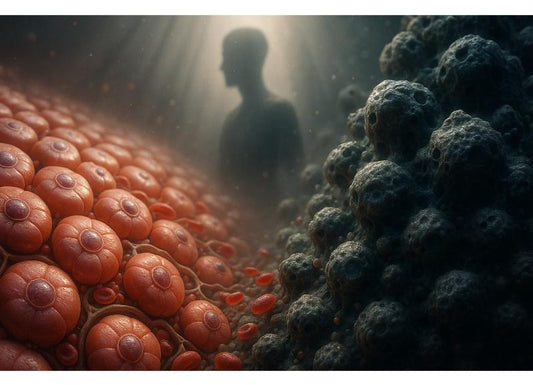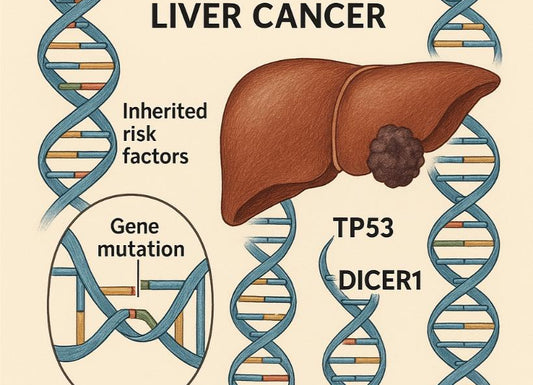What is the First Sign of Liver Cancer? Things to Know
 Written By
Jaclyn P. Leyson-Azuela, RMT, MD, MPH
Written By
Jaclyn P. Leyson-Azuela, RMT, MD, MPH

Liver cancer can start quietly, often without obvious symptoms so asking the question “what is the first sign of liver cancer” may prove to be difficult to answer. Many people will only notice subtle signs at first, like tiredness, appetite loss, or a feeling of fullness in the upper right abdomen. Knowing what to watch for helps you catch warning signs early and seek medical care when it matters most.
This article explains the earliest indicators of liver cancer, how they appear, and how you can use both medical and at-home tools to monitor your liver health effectively.
Key Insights
-
Liver cancer often begins quietly with mild symptoms like fatigue and appetite loss.
-
Upper right abdominal discomfort is one of the most telling early signs.
-
Urine color changes can signal liver distress before pain appears.
-
At-home urine strips detect bilirubin and urobilinogen changes early.
-
Routine checkups and blood tests are essential for at-risk individuals.
-
Early diagnosis improves treatment success and life expectancy.
What Are the Most Common Early Symptoms of Liver Cancer?
If you’re wondering what the first sign of liver cancer looks like, the truth is that it often begins subtly. In the early stages, symptoms may not be clear or may even resemble common digestive issues or an entirely different condition altogether. However, there are specific early warning signs you should know and would warrant further medical investigation.
Common early warning signs
The most typical warning symptoms include:
-
Unexplained fatigue that doesn’t improve with rest
-
Loss of appetite or feeling full after small meals
-
Upper right abdominal pain or discomfort below the ribs
-
Nausea or vomiting without a clear cause
-
Unexplained weight loss despite no diet changes
-
Yellowing of the skin or eyes (jaundice) in later stages
These signs develop as the liver becomes damaged or enlarged by tumor growth. The upper right quadrant pain happens because the liver capsule stretches, causing discomfort or a dull ache.
What causes a swollen abdomen in liver cancer?
Swelling in the abdomen, called ascites, occurs when fluid builds up due to blocked blood flow and pressure in the liver. This symptom usually develops later but may begin early if tumors block blood circulation. A swollen belly can make you feel full or even short of breath.
If you notice bloating that worsens over days or weeks, contact your doctor for testing.
Can unexplained weight loss be a sign of liver cancer?
Yes. Rapid unexplained weight loss (also known as cachexia) is one of the earliest systemic cues that the liver is not working properly. The body may break down muscle and fat tissue for energy when liver cells are damaged. Persistent loss of appetite often adds to this problem.
Tracking your body weight weekly can help you notice any downward trends or patterns that are unusual for you.

How Is Liver Cancer Diagnosed — Can Home Tests Help?
Early detection saves lives, that is for sure. Since symptoms can be vague and overlapping with other conditions, most liver cancers are diagnosed only after medical imaging, lab work, or even biopsy. However, some at-home urine tests may help monitor liver function in between routine doctor visits.
How is liver cancer diagnosed by professionals?
Your doctor will use several methods to confirm or identify liver cancer:
-
Blood testing, such as elevated liver enzymes (e.g., ALT, AST, and ALP) and a tumor marker called alpha-fetoprotein (AFP), which can be combined with ultrasound to increase the sensitivity to about 83-100% in early stage liver cancer
-
Imaging scans like ultrasound, CT, or MRI can reveal masses or abnormal tissue growth
-
Biopsy is an invasive test, which takes a small sample of tissue that can confirm the cancer type and the stage
Your doctor will also evaluate you for hepatocellular carcinoma (HCC), which is the most common form of primary liver cancer accounting for about 85-90% of all liver cancer cases.
What are laboratory markers for early liver cancer?
Some lab clues can appear even before symptoms do.
-
AFP levels that are more than 400 ng/mL suggest liver cancer
-
Bilirubin levels tend to be higher, which may cause yellowing of the skin or eyes (jaundice)
-
Liver enzymes (ALT, AST) are often elevated due to ongoing liver cell damage
-
Prothrombin time, which could reveal an increase in clotting time, reflecting a poor liver function
If you have a history of hepatitis B, hepatitis C, or cirrhosis, your doctor may recommend regular blood work every 6–12 months. However, guidelines indicate that specific groups of people need to have ultrasound and AFP testing every 6 months, including:
-
People with cirrhosis
-
People with a family history of HCC
-
People with hepatitis
Can at-home tests help with early detection?
While at-home urine test strips cannot diagnose liver cancer, they can track indicators of liver stress, such as:
-
Bilirubin levels in the form of urobilinogen
-
Protein in the urine (proteinuria)
-
Blood in the urine (hematuria)
Consistently abnormal at-home urine results should prompt you to visit a healthcare provider for full and comprehensive evaluation or testing. These tools only provide a convenient and accessible way to proactively monitor your health between medical appointments.

When Should You Contact Your Doctor About Possible Liver Cancer?
You should seek medical attention as soon as you notice symptoms that persist beyond a few days or weeks. Liver cancer often progresses silently, so early communication with your healthcare provider is key to having a better outlook.
When do you need a professional diagnosis vs. home screening?
You should contact your doctor immediately if you experience:
-
Ongoing upper abdominal pain
-
Yellowing of the skin or eyes
-
Dark-colored urine or pale stools
-
Extreme fatigue
-
Unexpected weight loss or bloating
At-home testing is meant for monitoring, not for diagnosis. Your doctor can confirm results using blood panels and imaging.
How long can you have liver cancer without symptoms?
The symptoms of liver cancer can be very vague and can be mistaken for some other things. The liver can function with minimal damage until tumor size interferes with normal processes. Therefore, it can be hard to know how long it’s going to take without symptoms.
However, there may be factors that influence how quickly the symptoms appear including:
-
Type and size of tumor
-
Presence of cirrhosis
-
Overall health and immune response
-
Lifestyle habits such as alcohol use or diet
Because of this, routine liver function testing is crucial, particularly for individuals with known risk factors mentioned earlier.

What happens after your appointment
If initial tests suggest liver damage, your doctor may recommend:
-
Ultrasound or MRI
-
AFP and bilirubin blood testing
-
Referral to a gastroenterologist or hepatologist
If cancer is detected early, surgical resection or targeted therapy can improve survival rates significantly. So, at-home urine testing remains a useful tool for ongoing monitoring but does not replace professional evaluation.
Can At-Home Urine Test Strips Detect Early Liver Cancer Warning Signs?
At-home urine strips are a convenient way to track liver-related health changes, though they cannot confirm cancer on their own. These tests can detect some chemical markers that could suggest liver stress or damage in the liver.
What color changes in urine may signal liver issues?
Urine color can tell you a lot about your liver. Dark brown or tea-colored urine often suggests bilirubin buildup, which is a common sign of liver dysfunction. Pale or foamy urine may indicate protein leakage or reduced bile production.
If these changes last more than a few days, consult your doctor or schedule a liver function test.
How to use at-home urine test strips
-
Collect a midstream clean catch urine sample in a sterile container (often kits include this urine container)
-
Dip the test strip according to instruction within the product packaging
-
Compare the color changes on the strip to the chart provided on the kit or if you subscribe to a smartphone-based app that will automatically read the result with the help of the AI, you can take the image of the strip
-
Record the results on a journal and look for trends over time
Regular tracking can help you spot early variations in bilirubin or urobilinogen, which may point to liver stress.
What do test results mean?
A positive bilirubin or urobilinogen reading could suggest but not confirm:
-
Obstructed bile flow
-
Hepatitis infection (inflamed liver)
-
Early liver tissue damage
However, even with these results, these do not automatically mean you have liver cancer. They act as screening clues that tell you when to follow up with a medical professional test.
Monitoring Liver Health at Home
Caring for your liver starts with awareness. Home-based tools like urine test strips and digital symptom trackers help you observe patterns that might require attention.
Simple ways to track your liver health
-
Use at-home urine strips weekly to check for bilirubin or protein changes.
-
Record weight and appetite changes in a notebook or app.
-
Track energy levels and note how you feel throughout the day.
-
Watch for color changes in urine or stool.
When to bring results to your doctor
If your home results show persistent abnormalities, bring those records to your doctor as soon as possible. Doctors will appreciate consistent data tracking that demonstrates trends or patterns over time. This combined approach, self monitoring and medical evaluation, gives you a clearer picture of your liver’s condition.
What Are Risk Factors That Increase Your Chance of Developing Liver Cancer?
Understanding your risk helps you take proactive steps toward prevention and early detection.

Common risk factors
The main contributors to liver cancer include:
-
Chronic hepatitis B or C infection
-
Cirrhosis caused by alcohol or fatty liver disease
-
Obesity and type 2 diabetes
-
Exposure to aflatoxins (toxins from moldy grains or peanuts)
-
Heavy alcohol consumption
-
Non-alcoholic fatty liver disease (NAFLD)
-
Family history of liver cancer
How lifestyle affects risk
Small lifestyle choices make a big difference:
-
Limit alcohol intake
-
Maintain a healthy weight
-
Eat a balanced diet rich in vegetables, lean protein, and whole grains
-
Avoid unnecessary medications that strain the liver
-
Consider hepatitis B vaccination if you’re at risk
Prevention and Early Action
While not all liver cancers are preventable, many risk factors are manageable with lifestyle adjustments and screening.
How to lower your risk
-
Get vaccinated against hepatitis B if you haven’t already.
-
Avoid sharing razors, needles, or personal hygiene tools.
-
Maintain a healthy weight and manage diabetes carefully.
-
Reduce alcohol consumption and limit processed foods.
-
Eat fiber-rich foods like oats, beans, and vegetables to help the liver process toxins.
Living With and Managing Liver Cancer
A diagnosis of liver cancer can feel overwhelming, but support and treatment options are available. Managing the condition involves medical care, nutrition, and emotional well-being.
What treatment looks like
Depending on the stage, your doctor may suggest:
-
Surgery to remove part of the liver (called resection)
-
Radiofrequency ablation to destroy small tumors
-
Transplantation for eligible patients
-
Targeted or immunotherapy to stop cancer cell growth
Early detection can make many of these options viable. In later stages, treatments focus on symptom relief and quality of life.
Lifestyle support
You can improve your health outcomes by:
-
Eating small, balanced meals with high protein
-
Avoid alcohol completely
-
Get enough rest
-
Join support groups for patients and families
Many patients use home monitoring tools to maintain awareness and detect changes early, helping guide conversations with their healthcare team.
Related Resources
Is Liver Cancer Hereditary? Genetic Risks and Family History
Is Liver Cancer Curable? Things to Know
What Are the Signs That Pancreatic Cancer Has Spread to Liver?
Quick Summary Box
-
Early signs of liver cancer include fatigue, weight loss, or upper abdominal pain
-
Primary causes include hepatitis B or C, cirrhosis, obesity, and alcohol use
-
Diagnosis is primarily done through blood tests (e.g., AFP, bilirubin), imaging, and biopsy
-
Home screening (e.g., urine test strips) detect urobilinogen changes
-
You should see your doctor when you have persistent fatigue, jaundice, dark urine, or swelling
-
Prevention may be achieved by getting vaccinated, eating healthy, and monitoring of your liver function

Jaclyn P. Leyson-Azuela, RMT, MD, MPH, is a licensed General Practitioner and Public Health Expert. She currently serves as a physician in private practice, combining clinical care with her passion for preventive health and community wellness.



